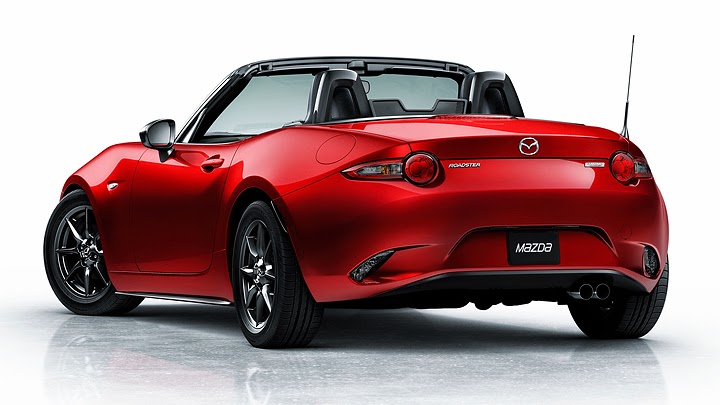
Those who have seen Mazda’s latest releases will not take long to spot Kodo language’s style cues. The headlights are small and angular, the creases have a great balance between looking muscular and discreet, and everything aids to a very dynamic look. However, “zooming out” a little bit will remind you of which particular model we are talking about. While any other car has got bigger and bigger over the years, the 3,915-mm length makes it the shortest MX-5 ever. Front and rear overhangs were reduced by 90 mm and the ride height by 20, so as to highlight how much it begs you to go to a long road full of tight turns. And the overall look was enhanced by the black-painted windshield arch, rearview mirrors and wheels: Mazda has restored the recipe which has been a huge hit since 1989.
Whether called Miata, MX-5 or Roadster (depending on the country), this car reminds very much of the inspirors of the original generation: typical British droptops. They have a minimalistic conception whose priority is the driving pleasure. The car looks very good and is very well-equipped, but is much more focused on the dynamic behavior. Therefore, Mazda dropped any unnecessary item, as well as made some external and structural parts in lightweight aluminum and a lighter fabric removable top, in order to reduce 100 kg from the previous roadster. Besides, the engine was pushed back in the nose, aiding to the perfect 50:50 weight balance between front and rear. Mazda’s intention was to adapt the concept of a lightweight, open-top sports car to today’s needs.
Opening the doors reveals a typical sports-car cabin. The wheelbase was reduced by 15 mm, but Mazda claims the internal space was not affected. The dashboard features a very, very pragmatic design, which concentrates most of its controls at the big touchscreen sitting above it: MZD Connect appears once again, with the possibility of pairing your smartphone to the car. Other interesting features are the optional hard-top, which will arrive later (the fabric top has only manual operation), new speakers in the headrests, and 195/50 R16 tyres. Yes, sixteen! Reducing both size and mass allowed Mazda’s convertible to accomplish its performance goals with alloy wheels small enough to be comparable to those of any compact hatchback of these days.
MX-5’s mélange of past and future elements appears once again at the tech specs. There will be six-speed manual transmission, rear-wheel-drive, only Skyactiv-G engines, and electrically-assisted steering, which is claimed to offer the same feel of the outgoing hydraulic equipment. As far as the engines are concerned, “Skyactiv” means they were filled with efficiency-focused technologies, whether to reduce fuel consumption or the emissions. That “G”, in turn, stands for the use of gasoline, for both the 1.5L and the 2.0L units: the second one will only be used in the United States. Mazda’s brand new roadster will make its official debut during this year’s Paris Auto Show, while the sales will start some months later.





